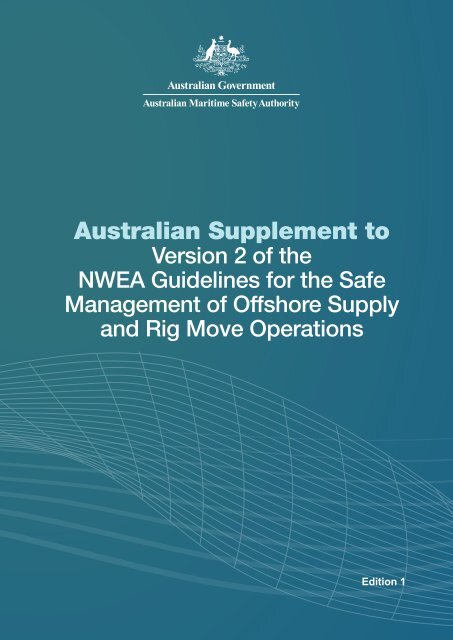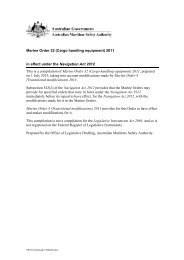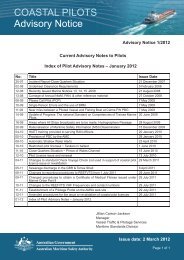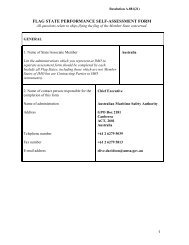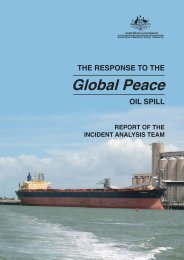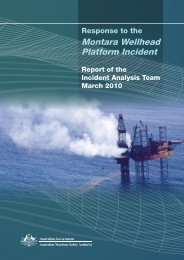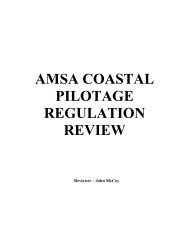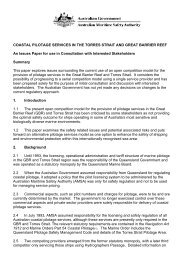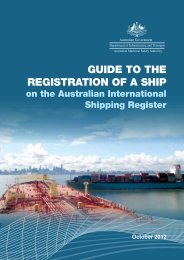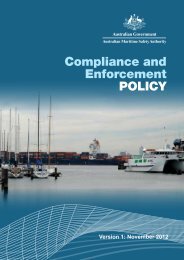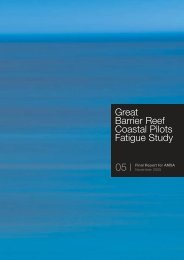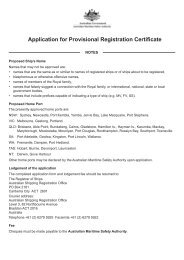Australian Supplement to - Australian Maritime Safety Authority
Australian Supplement to - Australian Maritime Safety Authority
Australian Supplement to - Australian Maritime Safety Authority
You also want an ePaper? Increase the reach of your titles
YUMPU automatically turns print PDFs into web optimized ePapers that Google loves.
<strong>Australian</strong> <strong>Supplement</strong> <strong>to</strong> Version 2 of the NWEA Guidelines for the<br />
Safe Management of Offshore Supply and Rig Move Operations<br />
<strong>Australian</strong> <strong>Supplement</strong> <strong>to</strong><br />
Version 2 of the<br />
NWEA Guidelines for the Safe<br />
Management of Offshore Supply<br />
and Rig Move Operations<br />
Edition 1<br />
Edition 1
Edition 1 Published Oc<strong>to</strong>ber 2011<br />
Disclaimer<br />
The use of this <strong>Australian</strong> <strong>Supplement</strong> does not affect the responsibility of the ship opera<strong>to</strong>r<br />
and master <strong>to</strong> operate safely and <strong>to</strong> observe statu<strong>to</strong>ry requirements, or <strong>to</strong> prevent any person<br />
exercising their normal duty of care.<br />
This document is not intended <strong>to</strong> conflict with or replace any applicable legislated requirements or<br />
contractual obligations.<br />
Edition 1
<strong>Australian</strong> <strong>Supplement</strong> <strong>to</strong> Version 2 of the NWEA Guidelines for the<br />
Safe Management of Offshore Supply and Rig Move Operations<br />
Contents<br />
Background 1<br />
Purpose 1<br />
Application 1<br />
Review process 1<br />
Declared vessels 1<br />
Interaction with offshore facilities 1<br />
Abbreviations 2<br />
The reason for the <strong>Australian</strong> <strong>Supplement</strong> 3<br />
Numbering aligns with applicable sections of the NWEA Guidelines Version 2<br />
3 Operations 4<br />
4 Bulk Cargo Operations 4<br />
6 Rig Moving 5<br />
7 Risk Management 5<br />
9 Training, Competency & Manning 6<br />
10 Emergencies 7<br />
11 Security 8<br />
Annex F Cargo Segregation Table 8<br />
Annex O Bulk Cargo Hazard Overview 9<br />
Annex P Hand Signals for Crane Operations 9<br />
Annex Q References 10<br />
Additional Guidance Notes 13<br />
Additional <strong>Supplement</strong>ary advice NOPSA 14<br />
III<br />
Edition 1
<strong>Australian</strong> <strong>Supplement</strong> <strong>to</strong> Version 2 of the NWEA Guidelines for the<br />
Safe Management of Offshore Supply and Rig Move Operations<br />
IV<br />
Edition 1
<strong>Australian</strong> <strong>Supplement</strong> <strong>to</strong> Version 2 of the NWEA Guidelines for the<br />
Safe Management of Offshore Supply and Rig Move Operations<br />
Background<br />
The <strong>Australian</strong> Offshore Supply Vessel (OSV) sec<strong>to</strong>r has identified that the NWEA (North West<br />
European Area) Guidelines could, in principle, apply in the <strong>Australian</strong> OSV context. The <strong>Australian</strong><br />
<strong>Maritime</strong> <strong>Safety</strong> <strong>Authority</strong> (AMSA), through a process of consultation with industry, concluded that<br />
the NWEA Guidelines along with an <strong>Australian</strong> <strong>Supplement</strong> could replace the <strong>Australian</strong> Offshore<br />
Support Vessel Code of Safe Working Practice.<br />
Purpose<br />
This <strong>Australian</strong> <strong>Supplement</strong> is provided for guidance <strong>to</strong> owners, managers, marine<br />
superintendents, masters and crew of offshore support vessels when operating within the<br />
<strong>Australian</strong> exclusive economic zone (EEZ) in order <strong>to</strong> meet their obligations under Marine Orders<br />
Part 59, Issue 2 (Off-shore industry vessel operations).<br />
It is recommended that relevant parts of the NWEA Guidelines and this <strong>Australian</strong> <strong>Supplement</strong> be<br />
incorporated in<strong>to</strong> vessel safety management systems. This issue of the <strong>Australian</strong> <strong>Supplement</strong> is<br />
<strong>to</strong> be used in conjunction with Version 2 of the NWEA Guidelines.<br />
Application<br />
The NWEA Guidelines in conjunction with this <strong>Australian</strong> <strong>Supplement</strong> can be used in relation <strong>to</strong><br />
all OSVs engaged in the carriage of cargo, <strong>to</strong>wing and in anchor handling operations related <strong>to</strong><br />
offshore support and supply operations carried out under application of the Navigation Act 1912.<br />
Review process<br />
This <strong>Australian</strong> <strong>Supplement</strong> reflects particular requirements of the <strong>Australian</strong> offshore industry<br />
and, <strong>to</strong> keep pace with these requirements, this supplement will be periodically reviewed and<br />
amended in accordance with AMSA procedures.<br />
Declared vessels<br />
<strong>Australian</strong> registered and foreign flag OSVs can elect <strong>to</strong> declare under Section 8A of the<br />
Navigation Act 1912. This declaration brings an off-shore industry vessel under AMSA jurisdiction<br />
for all interstate and intrastate voyages. A declared vessel will be subject <strong>to</strong> the full application of<br />
the Occupational Health and <strong>Safety</strong> (<strong>Maritime</strong> Industry) Act 1993 when on voyages that fall under<br />
the jurisdiction of the Navigation Act 1912.<br />
Interaction with offshore facilities<br />
It is recommended that installation opera<strong>to</strong>rs accommodate complementary arrangements in<br />
their respective management systems and plans <strong>to</strong> enable safe operations with off-shore industry<br />
vessels operating under AMSA jurisdiction.<br />
1<br />
Edition 1
<strong>Australian</strong> <strong>Supplement</strong> <strong>to</strong> Version 2 of the NWEA Guidelines for the<br />
Safe Management of Offshore Supply and Rig Move Operations<br />
Abbreviations<br />
AHV<br />
AMSA<br />
AQIS<br />
DAFF<br />
DNV<br />
EEZ<br />
E/R<br />
IMCA<br />
IMO<br />
IMDG<br />
IPIECA<br />
ISM Code<br />
ISPS<br />
JSA<br />
NOPSA<br />
MN<br />
MO<br />
MOU<br />
MSC<br />
MSF<br />
NAV Act<br />
NMD<br />
NSA<br />
NWEA<br />
OGP<br />
Anchor Handling Vessel<br />
<strong>Australian</strong> <strong>Maritime</strong> <strong>Safety</strong> <strong>Authority</strong><br />
<strong>Australian</strong> Quarantine and Inspection Service – a department of DAFF<br />
Department of Agriculture Fisheries and Forestry<br />
Det Norske Veritas<br />
(<strong>Australian</strong>) Exclusive Economic Zone<br />
Engine Room<br />
International Marine Contrac<strong>to</strong>rs Association<br />
International <strong>Maritime</strong> Organization<br />
International <strong>Maritime</strong> Dangerous Goods<br />
International Petroleum Industry Environmental Conservation Association<br />
International <strong>Safety</strong> Management Code<br />
International Ship and Ports Facility Security Code<br />
Job <strong>Safety</strong> Analysis or Assessment<br />
National Offshore Petroleum <strong>Safety</strong> <strong>Authority</strong><br />
Marine Notices<br />
Marine Orders Part issued by AMSA under the Navigation Act 1912, as amended<br />
Mobile Offshore Unit<br />
<strong>Maritime</strong> <strong>Safety</strong> Committee – a committee of the IMO<br />
Marine <strong>Safety</strong> Forum<br />
Navigation Act 1912, as amended<br />
Norwegian <strong>Maritime</strong> Direc<strong>to</strong>rate<br />
Norwegian Shipowners’ Association<br />
North West European Area<br />
International Association of Oil and Gas Producers<br />
OH&S(MI) Act Occupational Health and <strong>Safety</strong> (<strong>Maritime</strong> Industry) Act 1993<br />
OHS<br />
OLF<br />
OSV<br />
OTS<br />
PCP<br />
PPE<br />
RCC<br />
SOLAS<br />
STCW<br />
UKOOA<br />
UKCS<br />
Occupational Health and <strong>Safety</strong><br />
Oljeindustriens Landsforening (Norwegian Oil Industry Association)<br />
Offshore supply vessel<br />
Office of Transport Security<br />
Permanent Chaser Pendant<br />
Personal Protective Equipment<br />
Rescue Coordination Centre<br />
International Convention for the <strong>Safety</strong> of Life at Sea<br />
International Convention on Standards of Training and Watchkeeping for<br />
Seafarers, 1978<br />
United Kingdom Offshore Opera<strong>to</strong>rs Association<br />
United Kingdom Continental Shelf<br />
2<br />
Edition 1
<strong>Australian</strong> <strong>Supplement</strong> <strong>to</strong> Version 2 of the NWEA Guidelines for the<br />
Safe Management of Offshore Supply and Rig Move Operations<br />
The reason for the <strong>Australian</strong> <strong>Supplement</strong><br />
In general the <strong>Australian</strong> <strong>Supplement</strong> applies <strong>to</strong> clauses in the NWEA Guidelines that are vessel<br />
specific. The <strong>Australian</strong> <strong>Supplement</strong> identifies clauses within the NWEA Guidelines that require<br />
clarification, interpretation or reference <strong>to</strong> further information.<br />
The relevant clause in the <strong>Australian</strong> <strong>Supplement</strong> will be either supplementary <strong>to</strong>, or a<br />
replacement for, the clause in the NWEA Guidelines.<br />
3<br />
Edition 1
<strong>Australian</strong> <strong>Supplement</strong> <strong>to</strong> Version 2 of the NWEA Guidelines for the<br />
Safe Management of Offshore Supply and Rig Move Operations<br />
3 Operations<br />
<strong>Australian</strong> <strong>Supplement</strong> clauses for the NWEA Guidelines Chapter 3 are:<br />
NWEA Clause Clause heading <strong>Australian</strong> <strong>Supplement</strong> guidance note<br />
3.1.2<br />
Replacement<br />
3.3.3.2.9<br />
Replacement<br />
3.3.6.5<br />
<strong>Supplement</strong>ary<br />
3.3.7<br />
<strong>Supplement</strong>ary<br />
Shipboard Lifting<br />
Operations in Port<br />
Radio Communication<br />
(including mobile<br />
phones)<br />
Backload Vessel<br />
Responsibilities (2)<br />
Personnel Transfers<br />
4 Bulk Cargo Operations<br />
Compliance with Marine Orders Part 32 Cargo<br />
Handling Equipment is required.<br />
Personal mobile phones must not be used by any<br />
person when:<br />
• The vessel is inside the safety zone.<br />
• During anchor handling operations.<br />
• Entering or leaving port.<br />
Ensure a JSA has been undertaken <strong>to</strong> minimise risk<br />
<strong>to</strong> crew on deck. Risk is <strong>to</strong> be as low as reasonably<br />
practicable.<br />
Personnel cradles and their use should be in<br />
accordance with Appendix 3 of Marine Orders Part<br />
32 Cargo Handling Equipment.<br />
Guidance is also provided at Section 10 of Marine<br />
Orders Part 60 Floating Offshore Facilities.<br />
<strong>Australian</strong> <strong>Supplement</strong> clauses for the NWEA Guidelines Chapter 4 are:<br />
NWEA Clause Clause heading <strong>Australian</strong> <strong>Supplement</strong> guidance note<br />
4.4.2<br />
Replacement<br />
Bulk Transfers of<br />
Particular Concern<br />
Compliance with Marine Orders Part 93 Marine<br />
Pollution Prevention - Noxious Liquid Substances is<br />
required.<br />
4<br />
Edition 1
<strong>Australian</strong> <strong>Supplement</strong> <strong>to</strong> Version 2 of the NWEA Guidelines for the<br />
Safe Management of Offshore Supply and Rig Move Operations<br />
6 Rig Moving<br />
<strong>Australian</strong> <strong>Supplement</strong> clauses for the NWEA Guidelines Chapter 6 are:<br />
NWEA Clause Clause heading <strong>Australian</strong> <strong>Supplement</strong> guidance note<br />
6.3<br />
<strong>Supplement</strong>ary<br />
6.6.3<br />
<strong>Supplement</strong>ary<br />
Rig Move Plan<br />
Pendant Return <strong>to</strong><br />
MOU<br />
7 Risk Management<br />
The agreed Rig Move Plan should be provided in an<br />
agreed timeframe <strong>to</strong> allow OSV crews adequate time<br />
<strong>to</strong> prepare for Rig Move Operations.<br />
To reduce shock loads on the installation crane when<br />
passing PCP back, the use of tugger wires should be<br />
considered <strong>to</strong> pay the PCP out <strong>to</strong> the stern roller before<br />
releasing the weight <strong>to</strong> the installation crane.<br />
For further notes see NWEA v2 Annex N.<br />
<strong>Australian</strong> <strong>Supplement</strong> clauses for the NWEA Guidelines Chapter 7 are:<br />
NWEA Clause Clause heading <strong>Australian</strong> <strong>Supplement</strong> guidance note<br />
7.3.3<br />
<strong>Supplement</strong>ary<br />
7.5<br />
<strong>Supplement</strong>ary<br />
Permit <strong>to</strong> Work<br />
PPE<br />
<strong>Supplement</strong>ary permit-<strong>to</strong>-work systems guidance is<br />
provided by the Code of Safe Working Practice for<br />
<strong>Australian</strong> Seafarers. Details can be found on AMSA’s<br />
website (www.amsa.gov.au)<br />
PPE Guidance is provided in Code of Safe Working<br />
Practice for the <strong>Australian</strong> Seafarer.<br />
5<br />
Edition 1
<strong>Australian</strong> <strong>Supplement</strong> <strong>to</strong> Version 2 of the NWEA Guidelines for the<br />
Safe Management of Offshore Supply and Rig Move Operations<br />
9 Training, Competency and Manning<br />
<strong>Australian</strong> <strong>Supplement</strong> clauses for the NWEA Guidelines Chapter 9 are:<br />
NWEA Clause Clause heading <strong>Australian</strong> <strong>Supplement</strong> guidance note<br />
9.2.2<br />
Replacement<br />
9.2.3<br />
Replacement<br />
9.1.4 (8)<br />
<strong>Supplement</strong>ary<br />
Supply Vessels<br />
within the <strong>Safety</strong><br />
Zone<br />
Anchor Handling<br />
Vessels<br />
Crane Opera<strong>to</strong>rs<br />
(Installation)<br />
Guidance is provided in Marine Orders Part 58<br />
International <strong>Safety</strong> Management Code (ISM).<br />
The ISM Code requires a company <strong>to</strong> ensure that its<br />
vessels are manned with qualified, certificated and<br />
medically fit seafarers in accordance with national and<br />
international requirements.<br />
Guidance provided in Marine Orders Part 28 Operations<br />
Standards and Procedures, requires that companies,<br />
masters, chief engineers and all persons engaged on<br />
watch keeping duties must observe both the standards<br />
and the guidance regarding watch keeping and fitness<br />
for duty set out in Chapter VIII of the Standards of<br />
Training Certification and Watch keeping Code.<br />
Additional Guidance is provided in Marine Orders<br />
Part 58 International <strong>Safety</strong> Management Code, and<br />
Marine Notice 9/2012.<br />
A company is responsible for ensuring that a vessel<br />
is manned <strong>to</strong> meet operational requirements and<br />
importantly <strong>to</strong> address the risk of fatigue.<br />
Fatigue is a hazard <strong>to</strong> personnel within the offshore<br />
industry and a threat <strong>to</strong> offshore safety. In view of this<br />
and <strong>to</strong> minimize the possibility of fatigue the following<br />
should be taken in<strong>to</strong> account:<br />
• the necessity for onboard relief for Master and crew<br />
in case of prolonged operations;<br />
• the effects of bad weather during offshore operations;<br />
• the level of onboard au<strong>to</strong>mation (bridge; E/R; deck<br />
machinery);<br />
• the need for proper onboard victualling<br />
arrangements;<br />
• voyage patterns and repairs/husbandry support;<br />
• crew training and competence; and<br />
• the nature and extent of the work <strong>to</strong> be undertaken<br />
including special needs of the installation.<br />
Installation Crane Opera<strong>to</strong>rs should be trained and<br />
competent with the requirements for the transfer of<br />
persons or goods between a ship and a facility.<br />
See also MO 59, 5 Application (Note 2).<br />
6<br />
Edition 1
<strong>Australian</strong> <strong>Supplement</strong> <strong>to</strong> Version 2 of the NWEA Guidelines for the<br />
Safe Management of Offshore Supply and Rig Move Operations<br />
10 Emergencies<br />
<strong>Australian</strong> <strong>Supplement</strong> clauses for the NWEA Guidelines Chapter 10 are:<br />
NWEA Clause Clause heading <strong>Australian</strong> <strong>Supplement</strong> guidance note<br />
10.1.2<br />
<strong>Supplement</strong>ary<br />
10.1.2<br />
<strong>Supplement</strong>ary<br />
10.3<br />
Replacement<br />
10.4<br />
Replacement<br />
10.5<br />
<strong>Supplement</strong>ary<br />
Installation<br />
Emergencies<br />
Installation<br />
Emergencies<br />
Opera<strong>to</strong>rs<br />
Cooperative<br />
Emergency<br />
Service<br />
Search and<br />
Rescue Contacts<br />
Emergency<br />
Towage<br />
Arrangements<br />
(new heading)<br />
Crews on standby vessels should consider all risks<br />
associated with operations inside an installation’s<br />
<strong>Safety</strong> Zone including those identified in the NWEA<br />
Guidelines.<br />
Ships shall prepare <strong>to</strong> respond <strong>to</strong> installation<br />
emergencies as per installation / project emergency<br />
plans. As a minimum the installation emergencies <strong>to</strong> be<br />
considered should include:<br />
• Capsize of installation.<br />
• Fire or explosion on the installation.<br />
• Collision, grounding or wreck of installation.<br />
• An accident involving helicopters on installation.<br />
• Cyclone.<br />
<strong>Maritime</strong> rescue operations within Australia’s EEZ<br />
are coordinated by the AMSA operated Rescue<br />
Coordination Centre - <strong>Australian</strong> (RCC-Australia).<br />
The RCC is responsible for coordinating maritime and<br />
aviation search and rescue over sections of the Indian,<br />
Southern and Pacific Oceans.<br />
Also see www.amsa.gov.au and Marine Orders Part 63<br />
AUSREP.<br />
The 24 hour emergency contact details for the RCC are:<br />
• <strong>Maritime</strong> Tel: 1800 641 792 or +61 2 6230 6811<br />
• Aviation Tel: 1800 815 257 or +61 2 6230 6899<br />
• Facsimile: 1800 622 153<br />
1800 643 586<br />
• Web: www.amsa.gov.au<br />
AMSA has emergency <strong>to</strong>wage arrangements within the<br />
<strong>Australian</strong> EEZ.<br />
www.amsa.gov.au/Marine_Environment_Protection/<br />
National_<strong>Maritime</strong>_Emergency_Response_<br />
Arrangements<br />
Marine Notice 8/2009 National <strong>Maritime</strong> Emergency<br />
Response Arrangement.<br />
7<br />
Edition 1
<strong>Australian</strong> <strong>Supplement</strong> <strong>to</strong> Version 2 of the NWEA Guidelines for the<br />
Safe Management of Offshore Supply and Rig Move Operations<br />
11 Security<br />
<strong>Australian</strong> <strong>Supplement</strong> clauses for the NWEA Guidelines Chapter 11 are:<br />
NWEA Clause Clause heading <strong>Australian</strong> <strong>Supplement</strong> guidance note<br />
11.1.2<br />
Replacement<br />
Security<br />
Annex F Cargo Segregation Table<br />
The Office of Transport Security (OTS) under the<br />
Department of Infrastructure and Transport is the<br />
<strong>Australian</strong> federal government agency responsible for<br />
maritime security and the International Ship and Ports<br />
Facility Security Code (ISPS).<br />
Seafarers on <strong>Australian</strong> regulated ships and people<br />
who work on and/or supply offshore oil and gas facilities<br />
require a <strong>Maritime</strong> Security Identification Card (MSIC)<br />
issued by the Department of Infrastructure and Transport<br />
<strong>to</strong> gain access <strong>to</strong> port facilities.<br />
www.infrastructure.gov.au<br />
To report a maritime transport security incident contact<br />
OTS (24-hour emergency contact): 1300 307 288<br />
<strong>Australian</strong> <strong>Supplement</strong> Clauses for the NWEA Guidelines Annex F are:<br />
NWEA Clause Clause heading <strong>Australian</strong> <strong>Supplement</strong> guidance note<br />
Annex F1 & F2<br />
Replacement<br />
Cargo Segregation<br />
Table<br />
The carriage of packaged dangerous goods is required<br />
<strong>to</strong> be conducted in accordance with Marine Orders<br />
Part 41 Carriage of Dangerous Goods. This Order<br />
implements the requirements of the International<br />
<strong>Maritime</strong> Dangerous Goods (IMDG) Code.<br />
Due <strong>to</strong> the nature of their operations OSV’s may apply<br />
for an exemption related <strong>to</strong> notification and segregation<br />
requirements by applying <strong>to</strong> AMSA.<br />
www.dangerousgoods@amsa.gov.au<br />
Also see www.amsa.gov.au<br />
8<br />
Edition 1
<strong>Australian</strong> <strong>Supplement</strong> <strong>to</strong> Version 2 of the NWEA Guidelines for the<br />
Safe Management of Offshore Supply and Rig Move Operations<br />
Annex O Bulk Cargo Hazard Overview<br />
<strong>Australian</strong> <strong>Supplement</strong> clauses for the NWEA Guidelines Annex O are:<br />
NWEA Clause Clause heading <strong>Australian</strong> <strong>Supplement</strong> guidance note<br />
Annex O<br />
<strong>Supplement</strong>ary<br />
<strong>Supplement</strong>ary<br />
Bulk Cargo<br />
Hazard Overview<br />
Hazard Drilling<br />
Fluids<br />
(new heading)<br />
Refer <strong>to</strong> Marine Orders Part 41 Carriage of Dangerous<br />
Goods, MN 20/2008 Amendments <strong>to</strong> Marine Orders Part<br />
41 and the International <strong>Maritime</strong> Dangerous Goods<br />
(IMDG) Code. Both documents are available at<br />
www.amsa.gov.au<br />
Guidance is provided by OGP report Number 396,<br />
IPIECA Drilling Fluids and Health Risk Management<br />
- A guide for drilling personnel, managers and health<br />
professionals in the oil and gas industry.<br />
Annex P Hand Signals for Crane Operations<br />
<strong>Australian</strong> <strong>Supplement</strong> clauses for the NWEA Guidelines Annex P are:<br />
NWEA Clause Clause heading <strong>Australian</strong> <strong>Supplement</strong> guidance note<br />
Annex P<br />
Replacement<br />
Hand Signals for<br />
Crane Operations<br />
Where hand signals are <strong>to</strong> be used they should be<br />
agreed between the OSV and facility or shore based<br />
before any crane operation commences. The hand<br />
signals for crane operations illustrated in Annex P of the<br />
Guidelines can be used.<br />
9<br />
Edition 1
<strong>Australian</strong> <strong>Supplement</strong> <strong>to</strong> Version 2 of the NWEA Guidelines for the<br />
Safe Management of Offshore Supply and Rig Move Operations<br />
Annex Q References<br />
Note: The following replaces Annex Q of the NWEA Guidelines in its entirety.<br />
<strong>Australian</strong> <strong>Supplement</strong> references for the NWEA Guidelines Annex Q are:<br />
No.<br />
General<br />
Reference<br />
Anchor Handling & Towing<br />
1 OLF/NSA Guidelines for <strong>Safety</strong> and Emergency Preparedness Training<br />
2 OLF/ NSA Acceptance Criteria for Offshore Service Vessels<br />
3 UKOOA Guidelines for Anchor Handling in the Vicinity of UKCS Installations,<br />
Pipelines and Their Subsea Equipment<br />
4 Marine Orders Part 12 Construction – Subdivision and Stability, Machinery and<br />
Electrical Installations<br />
Marine Orders Part 14 Accommodation<br />
Marine Orders Part 15 Construction – Fire Protection, Fire Detection and Fire<br />
Extinction<br />
Marine Orders Part 16 Load Lines<br />
Marine Orders Part 31 Ship Surveys and Certification<br />
Marine Orders Part 49 High Speed Craft<br />
5 Marine Orders Part 47 Mobile Offshore Drilling Units<br />
6 Marine Orders Part 58 International <strong>Safety</strong> Management Code<br />
7 OLF/NSA 061 Guidelines for Safe Operation of Offshore Service Vessels<br />
8 DNV Rules for Planning and Execution of Marine Operations<br />
9 MSF Template for Data for AHV’s<br />
10 MSF Guidelines for the content of Rig move procedures<br />
11 MSF Anchor Handling Manual Template<br />
Accident Reporting<br />
12 Transport <strong>Safety</strong> Investigation Act 2003<br />
Section 268 of the Navigation Act 1912<br />
Marine Notice 25/2007 OH&S Incident Report Analysis<br />
www.amsa.gov.au/Shipping_<strong>Safety</strong>/Incident_Reporting/index.asp<br />
13 Occupational Health and <strong>Safety</strong> (<strong>Maritime</strong> Industry) Act 1993<br />
Bulk Transfers<br />
14 IMO Resolution A.673(16) (as amended) – Guidelines for the Transport and Handling<br />
of Limited Amounts of Hazardous and Noxious Liquid Substances in Bulk in Offshore<br />
Support Vessels<br />
Cargoes<br />
15 Marine Orders Part 32 Cargo Handling Equipment<br />
Marine Orders Part 41 Carriage of Dangerous Goods<br />
Cargo carrying units / Containers<br />
10<br />
Edition 1
<strong>Australian</strong> <strong>Supplement</strong> <strong>to</strong> Version 2 of the NWEA Guidelines for the<br />
Safe Management of Offshore Supply and Rig Move Operations<br />
No.<br />
Reference<br />
16 IMO Circular MSC/Circ.860 - Guidelines for the Approval of Containers Handled in<br />
Open Seas.<br />
17 & 18 Marine Orders Part 44 Safe Containers<br />
Marine Orders Part 42 Cargo S<strong>to</strong>wage and Securing<br />
Dangerous Goods<br />
19-27 Marine Orders Part 41 Carriage of Dangerous Goods<br />
Drilling Fluids and Health Risk Management - A guide for drilling personnel,<br />
managers & health professionals in the oil & gas industry OGP report Number 396,<br />
IPIECA www.ipieca.org<br />
Gangways etc<br />
28 Marine Orders Part 32 Cargo Handling Equipment<br />
Health and <strong>Safety</strong><br />
29-32 Occupational Health and <strong>Safety</strong> (<strong>Maritime</strong> Industry) Act 1993<br />
33 Navigation Act 1912<br />
Marine Orders Part 32 Cargo Handling Equipment<br />
34 Code of Safe Working Practice for <strong>Australian</strong> Seafarers<br />
35 & 36 Marine Orders Part 32 Cargo Handling Equipment<br />
37 Marine Orders Part 21 <strong>Safety</strong> of Navigation and Emergency Procedures<br />
38 OLF Guidelines for <strong>Safety</strong> and Emergency Preparedness Training<br />
39 Marine Orders Part 21 <strong>Safety</strong> of Navigation and Emergency Procedures<br />
40 DNV-RP-H101 Risk Management in Marine and Subsea operations<br />
Hours of Work/STCW<br />
41 & 42 Marine Orders Part 28 Operations Standards and Procedures<br />
Interface between installation and vessel<br />
43 Offshore Petroleum and Greenhouse Gas S<strong>to</strong>rage Act 2006<br />
Marine Orders Part 47 Mobile Offshore Drilling Units<br />
Marine Orders Part 60 Floating Offshore Facilities<br />
44 UKOOA Guidance on Ship/ Installation Collision Avoidance<br />
45 Offshore Petroleum and Greenhouse Gas S<strong>to</strong>rage Act 2006<br />
Marine Orders Part 47 Mobile Offshore Drilling Units<br />
Marine Orders Part 60 Floating Offshore Facilities<br />
International<br />
46 IMO Resolution MSC.235 (82) - Adoption of the guidelines for the design and<br />
construction of offshore supply vessels, 2006 supersedes IMO Assembly<br />
resolution A.469(XII)<br />
11<br />
Edition 1
<strong>Australian</strong> <strong>Supplement</strong> <strong>to</strong> Version 2 of the NWEA Guidelines for the<br />
Safe Management of Offshore Supply and Rig Move Operations<br />
No.<br />
Reference<br />
47 IMO Resolution A.741(18) (as amended) - International management code for<br />
the safe operation of ships and for pollution prevention (International <strong>Safety</strong><br />
Management (ISM) Code).<br />
48 IMO Resolution A.863(20) (as amended) - Code of safe practices for the carriage of<br />
cargoes and person by offshore supply vessels (OSV Code).<br />
49 IMO circular MSC/Circ.645 - Guidelines for vessels with dynamic positioning systems<br />
Manning<br />
50 Marine Orders Part 28 Operations Standards and Procedures<br />
Masters Responsibility<br />
51 Marine Orders Part 28 Operations Standards and Procedures<br />
Merchant Shipping Legislation – General<br />
52 Navigation Act 1912<br />
Pollution Prevention<br />
53 & 54 Marine Orders Part 91 Marine Pollution Prevention - Oil<br />
Marine Orders Part 93 Marine Pollution Prevention - Noxious Liquid Substances<br />
Marine Orders Part 94 Marine Pollution Prevention - Packaged Harmful Substances<br />
Marine Orders Part 95 Marine Pollution Prevention - Garbage<br />
Marine Orders Part 96 Marine Pollution Prevention - Sewage<br />
Marine Orders Part 97 Marine Pollution Prevention - Air Pollution<br />
Marine Orders Part 98 Marine Pollution Prevention - Anti Fouling Systems<br />
Regula<strong>to</strong>ry Authorities – Demarcation<br />
55 Marine Orders Part 47 Mobile Offshore Drilling Units<br />
Marine Orders Part 60 Floating Offshore Facilities<br />
S<strong>to</strong>wage and Securing<br />
56 & 57 Marine Orders Part 42 Cargo S<strong>to</strong>wage and Securing<br />
Technical<br />
58 OLF ‘Guidelines for Acceptance Criteria for Offshore Service Vessels’ (No. 072)<br />
Training<br />
59 Marine Orders Part 61 Safe Working on Board Ships<br />
60 IMCA M182 ‘Guidelines for Safe Operation of Dynamically positioned Offshore<br />
Supply Vessels’<br />
Transfer and Towing<br />
61 NMD Regulations of 17 December 1986 relating <strong>to</strong> transfer and <strong>to</strong>wing of mobile<br />
installation as well as <strong>to</strong>wing arrangement and mooring of supply vessels on such<br />
installations (w/ associated guidelines and notices).<br />
12<br />
Edition 1
<strong>Australian</strong> <strong>Supplement</strong> <strong>to</strong> Version 2 of the NWEA Guidelines for the<br />
Safe Management of Offshore Supply and Rig Move Operations<br />
Additional Guidance Notes<br />
Issue<br />
Asbes<strong>to</strong>s<br />
Ballast water<br />
management<br />
Biofouling<br />
Cyclones and<br />
extreme weather<br />
Methanol<br />
OSV involvement<br />
in the evacuation<br />
of an installation<br />
Rescue craft<br />
Comment<br />
Asbes<strong>to</strong>s is prohibited for use on all <strong>Australian</strong> ships under the OH&S (MI)<br />
Act and associated regulations.<br />
‘Guidance of the Prohibition on the use of Asbes<strong>to</strong>s in the <strong>Australian</strong><br />
<strong>Maritime</strong> Industry Workplace’ is available from the Seacare website at<br />
www.seacare.gov.au<br />
Also refer <strong>to</strong> AMSA Marine Notice MN19/2008<br />
Ballast water management for ships arriving in Australia need <strong>to</strong> comply<br />
with the requirements of AQIS and DAFF.<br />
www.marinepests.gov.au/australian_ballast_water_management<br />
Biofouling requirements for ships in <strong>Australian</strong> waters may need <strong>to</strong> comply<br />
with the requirements of AQIS and DAFF.<br />
www.marinepests.gov.au<br />
Contingency plans for cyclones must be considered <strong>to</strong> minimise risk <strong>to</strong><br />
OSV crews, vessels and the marine environment.<br />
A hazardous cargo, <strong>to</strong> be used in line with Marine Orders Part 41 Carriage<br />
of Dangerous Goods and the IMDG Code.<br />
Consideration for the evacuation of an offshore facility <strong>to</strong> an OSV should be<br />
considered in agreements with offshore facilities. (West Atlas evacuation<br />
establishes precedent).<br />
Rescue craft crew must be competent and ready for immediate use of<br />
rescue craft. The rescue craft must be of a type approved fit for purpose<br />
and properly maintained.<br />
13<br />
Edition 1
<strong>Australian</strong> <strong>Supplement</strong> <strong>to</strong> Version 2 of the NWEA Guidelines for the<br />
Safe Management of Offshore Supply and Rig Move Operations<br />
Additional <strong>Supplement</strong>ary advice NOPSA<br />
Provided by National Offshore Petroleum <strong>Safety</strong> <strong>Authority</strong> re:<br />
Offshore Petroleum Facilities and the NWEA Guidelines<br />
This note is prepared in the context of activities performed at offshore petroleum facilities in<br />
relation <strong>to</strong> supply and anchor handling operations.<br />
Offshore petroleum OHS regula<strong>to</strong>ry regime:<br />
Occupational Health and <strong>Safety</strong> on offshore petroleum facilities in Commonwealth waters<br />
is regulated by the Offshore Petroleum and Greenhouse Gas S<strong>to</strong>rage Act 2006. (OPGGSA<br />
2006). Through the administration of Schedule 3 of the OPGGSA 2006 and associated<br />
regulations, the National Offshore Petroleum <strong>Safety</strong> <strong>Authority</strong> (NOPSA) has jurisdiction<br />
over OHS regulation at or near offshore facilities. The OHS regime is largely performance<br />
based with the primary obligation for safe operation of an offshore facility being the<br />
responsibility of its opera<strong>to</strong>r.<br />
Offshore petroleum facilities are defined in Schedule 3 of OPGGSA 2006. Fixed production<br />
platforms, Mobile Offshore Drilling Units (MODU), Floating Production S<strong>to</strong>rage and<br />
Offloading (FPSO) vessels and pipe laying vessels/barges are some examples of facilities.<br />
Supply vessels and anchor handling tugs are excluded from being facilities or<br />
associated offshore places (part of a facility).<br />
The opera<strong>to</strong>r of a facility has a duty <strong>to</strong> ensure that all activities on a facility are carried out<br />
in a manner that is safe and without risk <strong>to</strong> the health of any person at or near the facility.<br />
Activities that offshore supply vessels and anchor handling tugs are likely <strong>to</strong> be involved in<br />
at an offshore facility are loading and unloading, bunkering, personnel transfer preparations<br />
for <strong>to</strong>wing and anchor handling. (This is not an exhaustive list). Vessels used for supplying<br />
facilities or otherwise traveling between facility and the shore and anchor handling tugs are<br />
specifically excluded from the definition of a facility and the provisions of the OPGGSA 2006.<br />
<strong>Safety</strong> case:<br />
Regulations under the OPGGSA 2006 require each offshore petroleum facility <strong>to</strong><br />
have a safety case accepted by NOPSA. The safety management system described<br />
in this safety case must provide for all activities that take place at or in connection with a<br />
facility, including the activities in connection with vessels. The safety case must include<br />
a description of the system that ensures the safe performance of operations that<br />
involve vessels. An opera<strong>to</strong>r is required <strong>to</strong> comply with the accepted facility safety case<br />
that is in force.<br />
Standards:<br />
Standards must also be specified by the opera<strong>to</strong>r as part of the facility safety case. The<br />
industry developed NWEA Guidelines are standards of performance that have been<br />
developed <strong>to</strong> eliminate or reduce hazards and risks during supply or rig moving operations.<br />
In adopting this guidance on good practice an opera<strong>to</strong>r will be able <strong>to</strong> assure itself that it<br />
will achieve the safety goals set out in the OPGGSA 2006.<br />
The <strong>Australian</strong> <strong>Supplement</strong> and the NWEA Guidelines are not prescribed codes of<br />
practice under the provisions of the OPGGSA 2006.<br />
14<br />
Edition 1
<strong>Australian</strong> <strong>Supplement</strong> <strong>to</strong> Version 2 of the NWEA Guidelines for the<br />
Safe Management of Offshore Supply and Rig Move Operations<br />
Edition 1
<strong>Australian</strong> <strong>Supplement</strong> <strong>to</strong> Version 2 of the NWEA Guidelines for the<br />
Safe Management of Offshore Supply and Rig Move Operations<br />
AMSA 145 (10/11)<br />
Edition 1


